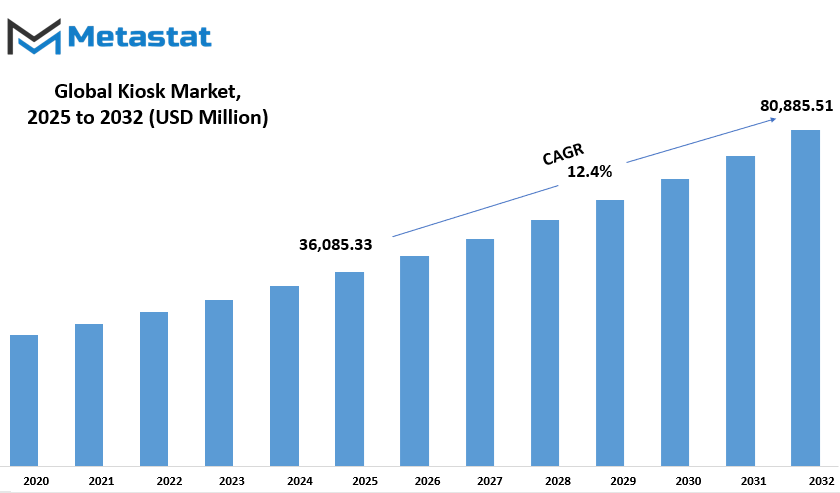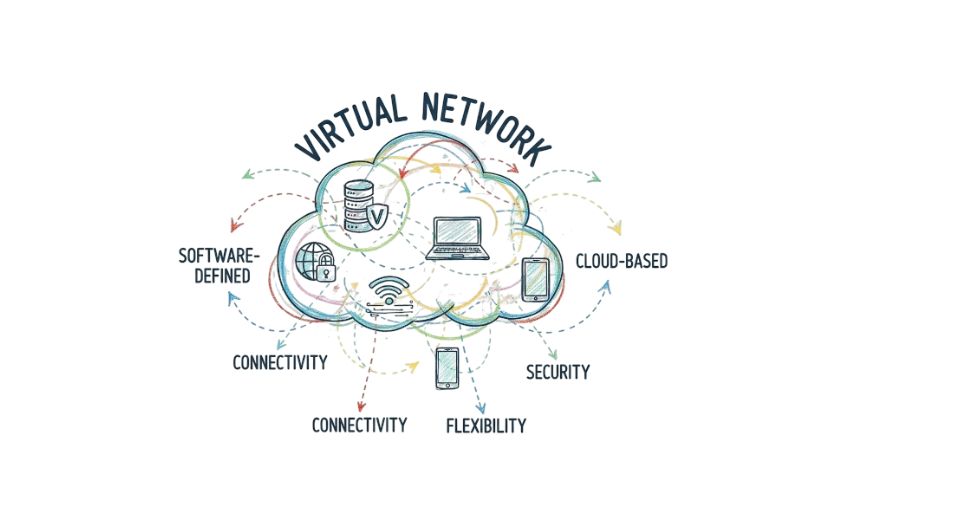MARKET OVERVIEW
This global kiosk market will change significantly beyond the conventional considerations of the industry analysis. Coupled with digital infrastructure and self-service technologies, the market would, in fact, stretch beyond hardware installation and software integration. Instead of all the historical discussions that revolve around products and regions, the future of this market will be made possible by deeper and less-surfaced dimensions involving digital interaction and behavioral alignment.
The kiosks will no longer fall in the realm of retail or transit carriers if societies become more deeply knitted into the digital fabric. Schools, health centers, and public governance will host interactive channels for community service due to the shifts in their core utilities from transactional interactions into interactive problem-solving. This will result in a cognitive interface-as though intelligent agents were taking on concrete form instead of dispensing tickets or acting as cash registers. This will reshape the relationship between technology and people sharing spaces.
The global kiosk market will gradually transform towards personalization based on immediate context. Unlike standardization scenarios of the previous models, such innovations define contextualized future mobility. Kiosks will provide learning content relevant to the students in schools and act dynamically to triage and exchange information about patients in hospitals. Their design will grow much more intuitive and seamlessly embedded in routine everyday activity, where users would not have to learn to engage-they would just engage and the machine responds appropriately.
The one thing that could now be said to be the least examined is the emotional intelligence that these units will develop-with the help of new technologies in sensory understanding and language parsing. Kiosks will start to assess the sentiment of the user and modify their output to achieve exchanges that are smoother and more human-like. Thus, they will not be passive installations anymore, but they will sense hesitations, detect patterns of stress, and guide individuals through processes in a gentle manner. Ambient assistants will fill the spaces with no presence within it.
The global kiosk market backbone will also change, since under-the-hood networks are supposed to support instant decision-making from a rather large decentralized data systems arrangement. So, now it will not be about centralized upgrades or late feedback loops, but access on the edge for kiosk ecosystems processing the critical information on the spot. Such change will enhance performance and data sovereignty-an important aspect for governments and institutions that wish to retain control over localized digital interactions.
Global kiosk market is estimated to reach $80,885.51 Million by 2032; growing at a CAGR of 12.4% from 2025 to 2032.

GROWTH FACTORS
The integration of artificial intelligence and IoT is set to be a trend in the global kiosk market, which will soon lead to enormous opportunities for businesses in the field. Technological advances in self-service ordering options are intended to improve user experiences while decreasing costs of labor and have therefore become adopted in several industries globally. Moreover, kiosks reduce the time an individual may wait while obtaining a product, service, or information, either with or without staff assistance.
This paradigm shift seems to find its highest levels of disruption in the retail, transit, healthcare, and banking markets, where speed and convenience will dominate customer satisfaction. Another key factor driving this growth is the rise of digital payments and automated retail systems. Fast and contactless transactions have become the norm-a great win-win for customers that demand no compromise in services. It is changing the service system, from checking in at airports to food ordering.
Conceivably, installing kiosks is an attractive concept, but there are other challenges that prevent actualization of maximum market opportunities for kiosks. One of the major challenges is the huge costs involved in the installation and maintenance of advanced Kiosks. The cost of setting up a kiosk that necessitates a continuous flow of updates and support can prove discouraging for many companies, particularly for small and medium-sized enterprises. Kiosk installation costs will thus create a significant hurdle to companies intending to transition to self-service systems but lacking the financial means to do so. Additionally, a key prevailing concern deals with data security and privacy. Data breaches or abuse will always hover above a kiosk-based system as a threat due to the sensitive information given during its operation, such as payment information or personal details. Protecting such information, thus, winning over the confidence of its users has been a consistent challenge for companies who wish to keep their customers secure while ensuring convenience online.
In light of this, there will also be a vast opportunity for growth for the global kiosk market in general as more technologies such as AI and IoT are adopted. This will, therefore, lead to the making of smarter kiosks which change or adapt according to user behavior, offering personalized promotions and operating much more efficiently. For example, a kiosk in a store could suggest products based on a customer's previous purchases or preferences for a more unique shopping experience. These smart capabilities could be harvested in wide applications, creating new avenues for customer engagement.
MARKET SEGMENTATION
By Type
The global kiosk market in general, is steadily increasing with many industrial adoptions of self-service technologies for better customer experience and the reduction in cost of operation. All this and many more are taking kiosks to improve service speed and enhance information availability. This market contains different types of kiosks designed for specific purposes. Bank Kiosk is one of the major segments valued at $12,357.34 million. These kiosks allow the customer to inquire about accounts and even apply for loans without wasting time in long queues or waiting. Banks are looking at installing this technology for the purpose of making the process simpler for customers as well as lessening the workload of their employees.
Another major segment includes vending kiosks. The vending kiosks are those that offer the sale of snacks, beverages, and personal grooming articles, etc. They are generally placed in very public places like malls, airports, hospitals, etc. so the locations allow easy access to these daily items. Modern vending kiosks are said to have advanced features such as cashless payment, mobile payment, and touchless operations. Ticketing kiosks are fast catching up, especially at transport and event venues. They save the consumer the time of having to deal with an agent to book or print tickets for buses, trains, cinemas, and concerts which improves customer service.
Patient interactive kiosks are changing the face of the healthcare sector as they provide patients with check-in for appointments, completing of forms, and access to medical records. This cutting down on time saves money and reduces the paperwork while making medical personnel free for more pressing duties. Finding an information kiosk is quite normal for many public establishments, such as shopping malls, museums, or government offices. They provide directions, maps, and answers to frequently asked questions without people needing to interact with someone to find their way or attain help. There are also kiosks used for functions as varied as gathering feedback from the public, advertising, and ordering food in restaurants.
There seems to be great demand for speed and contactless services. Therefore, in the future, kiosks are more likely to spread in almost all industries. Kiosks are becoming a real asset to both the consumer and business since they have the capacity to save time, reduce labor costs, and be rendered full-time service. The improvement occurring in technology will definitely make these kiosks easier and more efficient to operate in the nearest foreseeable future, thus further encouraging their adoption in everyday service and transactions.
By End-User Industry
Over many years worldwide demand for self-service applications and instantaneous interaction has simultaneously increased the global kiosk market. Various departments of business are now deploying kiosks for fast and efficient work, low-cost operations, and customer satisfaction. Today, these kiosks are found virtually anywhere; simple tasks relative would now be made easier and even smoother for customers and businesses alike.
In the retail line, kiosks are used for numerous self-checkout purposes, product information, and order placing. Kiosks help save long lines, cut down the number of staff needed, and ease the flow of traffic that is moving through the store for many reasons, such promotion and upselling. The speed and convenience of kiosks draw customers, especially under a busy store situation.
The kiosks are used by the banking, financial services and insurance (BFSI), and all these banking purposes of basic functions such as deposits, withdrawals, inquiries about account status and cash transfer to other parties, etc. Functions like these reduce the load from human staff and alleviate banks of a larger number of clients who are widely served in the remote areas. BSFIs place these machines on 24-hour availability for any banking service.
Kiosks have also become a budding boon to the hospitality sector. They are used in hotels to check in and out the guests, pick rooms, and pay. Guests do not need to stand before the front desk anymore; it is a quicker process that gives privacy. In restaurants, kiosks help patrons to order by themselves with minimal administration and more efficiency when the place is busiest.
The entertainment and gaming industry have similar kiosks used by movie theatres, gaming zones, and amusement parks for ticket booking and loading game credits for customers, which almost all such places have added, to minimize the wait for and annoyance to their customers.
Self-check-in and boarding passes, luggage tags, and info services are made possible by kiosks in the airport and hotel. With these machines, passenger movement can speed up and rapidly provide information for the unhindered traveler. Similar kinds of systems are used by hotels for room booking and customer preference management.
These kiosks are for IT and telecommunications industries, which have been used to sell SIM cards, do mobile recharge, customer care services, and bill payments. Very useful in crowded areas like malls and stations, wherever quick services are necessary.
Different government sectors like that in healthcare and education are proliferating the use of kiosks for various functions such as patient check-in, info services, and submission of forms. As industries and businesses strive for smart solutions to provide better services, demand for kiosks will rise even more, which will invariably lead to increased efficiencies.
|
Forecast Period |
2025-2032 |
|
Market Size in 2025 |
$36,085.33 million |
|
Market Size by 2032 |
$80,885.51 Million |
|
Growth Rate from 2025 to 2032 |
12.4% |
|
Base Year |
2024 |
|
Regions Covered |
North America, Europe, Asia-Pacific, South America, Middle East & Africa |
REGIONAL ANALYSIS
The global kiosk market, on a global plane, are organized according to the major regions of the world: North America, Europe, Asia Pacific, South America, and the Middle East & Africa. North America includes the U.S., Canada, and Mexico; Europe covers UK, Germany, France, and Italy, with the Rest of Europe; Asia-Pacific has the main markets in India, China, Japan, and South Korea, with the Rest of the Asia Pacific contributing to growth in the latter; South America has Brazil and Argentina, with the Rest of South America; and finally, the Middle East & Africa region is segmented into GCC Countries, Egypt, South Africa, and the Rest of the Middle East and Africa.
Every one of these regions has had its own role in the growth and development of the global kiosk market. North America, more specifically the United States, remains on top because of its advanced technology and strong existing infrastructure. The United States has a high supply requirement from kiosks due to their self-service options in retail, banking, transportation, etc. On the contrary, Canada and Mexico have, anyway, been on a slow path toward growth, unlike their North American counterpart.
There is an increased interest in modernizing the customer service processes in the European states of Germany and the UK. Kiosks are required in increasing numbers in retail stores, restaurants, and the healthcare arena. France and Italy are also contributing, particularly as self-service options become more widespread. The Rest of Europe comprises a few smaller markets with slow adoption of kiosk technology as it becomes available.
Asia-Pacific remains the fastest-growing global kiosk market. Digital infrastructure is being developed in China and India, which will see a rise in self-service kiosks in urban and semi-urban regions. Japan and South Korea, the advance tech economies in the region, are deploying kiosks in transportation and hospitality. The Rest of Asia-Pacific is driving demand where emerging markets have shown great interest in automation.
The South American market, consisting of Brazil and Argentina, is slowly picking up pace. Kiosks are being used more in environments such as public services and retail outlets. The Middle East and Africa region is developing with a good push from the countries of UAE and Saudi Arabia, both in the Gulf Cooperation Council. Together, Egypt and South Africa are increasingly adopting kiosks, particularly in banking and retail, while the rest of the region is catching up.

COMPETITIVE PLAYERS
The global kiosk market has moved towards a complete transformation globally in recent years with the increase of demand for self-service solutions in diverse applications. These interactive and self-service terminals can be found in retail stores, airports, banks, hospitals, and a number of other places to allow businesses to meet the needs of services in terms of speed and reduced operational costs while enhancing customer experience. Nowadays, more and more consumers prefer contactless and rapid services; kiosks have nowadays become a popular consideration for companies interested in offering convenience and efficiency in service. The increasing growth of the global kiosk market has stimulated the major technology players to make investments in kiosk systems and expand their operations in this area.
Many major companies are considerably shifting the course of the kiosk industry. NCR Corporation and Diebold Nixdorf, Incorporated are well-known in the development of financial and retail technology for more than a century. GLORY LTD. is also a special mention with its strong cash management systems that are often used to power kiosks in banks and other financial institutions. Samsung Electronics continues to roll out new display technologies that are majorly used in kiosks. KIOSK Information Systems and Olea Kiosks Inc. are prominent names for customized kiosks for a wide variety of sectors. Acrelec is another player in the self-service smart arena impacting the digital transformation of the retail and food sectors.
Other active suppliers in the industry are Shenzhen Hunghui IT Co. Ltd, Zebra Technologies Corp., and Meridian Kiosks, each providing a unique set of hardware and software that power advanced kiosk applications. FMA, Source Technologies, and Embross are some manufacturers that are known for reliable designs for medical facilities, transportation, and government services. NEXCOM International Co. Ltd and SZZT Electronics Co. Ltd are working on increased power and connectivity for better kiosk performance.
Slabb Inc., ESTECOM, Jassway, DynaTouch, etc., have established themselves as small yet impactful companies by offering user-friendly and affordable kiosks. The global kiosk market, they have made self-service technology available to small and medium businesses. Peerless-AV and Kiosk Group deal in high-performance enclosures and interactive solutions that help businesses attract and retain the attention of their customers, all wrapped up in modern sight and functionality.
Thus, the future of global kiosk market depends upon their continuous development together with high expectations of user experience. This synergy will foster further innovation, which will ultimately make kiosks more valuable as an asset for businesses in fast, smart, and reliable services.
Kiosk Market Key Segments:
By Type
- Bank Kiosks
- Vending Kiosks
- Ticketing Kiosks
- Patient Interactive Kiosks
- Information Kiosks
- Others
By End-User Industry
- Retail
- BFSI
- Hospitality
- Entertainment & Gaming
- Airports & Hotels
- IT/ Telecommunication
- Others
Key Global Kiosk Industry Players
- NCR Corporation
- Diebold Nixdorf, Incorporated
- GLORY LTD.
- Samsung Electronics
- KIOSK Information Systems
- Olea Kiosks Inc.
- Acrelec
- Shenzhen Hunghui IT Co. Ltd
- Zebra Technologies Corporation
- Meridian Kiosks
- Frank Mayer and Associates, Inc.
- Source Technologies
- Embross
- NEXCOM International Co. Ltd
- SZZT Electronics Co. Ltd
- Slabb Inc.
- ESTECOM
- Jassway
- DynaTouch
- Peerless-AV
- Kiosk Group
WHAT REPORT PROVIDES
- Full in-depth analysis of the parent Industry
- Important changes in market and its dynamics
- Segmentation details of the market
- Former, on-going, and projected market analysis in terms of volume and value
- Assessment of niche industry developments
- Market share analysis
- Key strategies of major players
- Emerging segments and regional growth potential








 US: +1 3023308252
US: +1 3023308252






